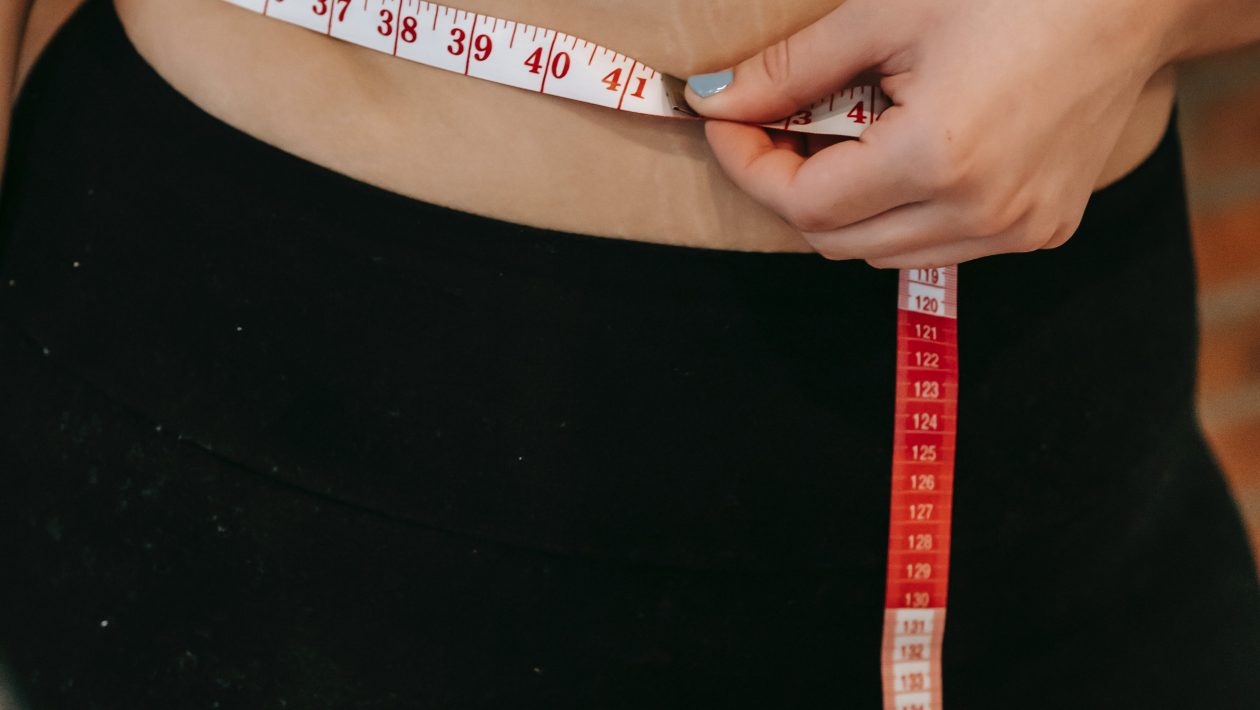Knowing what a PCOS belly can look like might just be an indication to get yourself diagnosed. It is natural to be curious about what a PCOS belly looks like, especially given how varied it may be. More so, if you have an irregular menstrual cycle and you grow an abnormal belly size the reasons to worry might multiply.
Around 8-13% of women go through this condition at some point of their lives. What’s worse is that 70% goes undiagnosed. We pledge to spread awareness and educate more women to help them understand their hormonal conditions.
Polycystic Ovary Syndrome affects every woman differently, and this includes how it affects the abdominal area. While some PCOS belly can look bigger and bloated, others might be small and round.
Due to this variation, it can be challenging to identify the precise appearance of a PCOS belly. However, it’s crucial to keep in mind that PCOS is more than only its outward symptoms.
Although physical appearance may play a role, PCOS is a complicated hormonal disorder. It has several other symptoms such as irregular periods, acne, excessive hair growth, and infertility.
Table of Contents
What is PCOS?
Polycystic Ovary Syndrome is a hormonal condition that affects of women who are of reproductive age. It is characterized by a number of symptoms.
These include, irregular menstrual periods, elevated levels of androgens (male hormones), and the occurrence of cysts in your ovaries. These hormone imbalances can cause a variety of physical and mental problems for people who are impacted.

If you have PCOS you’re also likely to have other symptoms like:
- Excess body hair
- Acne
- Weight gain in the abdomen area
- Hair loss or baldness
- Skin problems
- Infertility
What does a PCOS belly look like?
While PCOS predominantly affects the ovaries and impairs hormone function, one of the most noticeable signs of this disease is its influence on body weight and appearance.
As a result, women who have excess weight and irregular period often women what PCOS belly look like. Finding the answer is imperative not because of changes in physical appearance but to know how our hormones and metabolic functions alter in the process.
So, what does a PCOS belly look like? Well, for starters, it’s not your typical abdominal appearance. The appearance of a PCOS belly varies from person to person.
Women affected with PCOS usually have a firm belly which often remains tight. So, it becomes a challenge to lose weight around that area.
A PCOS belly possesses visceral fat, the type of fat that wraps around your internal organs. This visceral fat is not simply a cosmetic issue. It is far more dangerous than your normal fat.
It can often lead to an increased risk of heart disease, stroke, and type-2 diabetes. That’s why understanding what is going on with your PCOS belly becomes extremely crucial.
How to identify if you have a PCOS Belly?
There is no single technique to determine if you have a PCOS belly. Nevertheless, there are certain common symptoms that may suggest PCOS. Here are some common features of a PCOS stomach that you may endure if you have PCOS:
PCOS Belly Shape
A PCOS belly might cause you to have an apple-shaped figure. In that case, your waist will become broader than your hips.
Waist-to-Hip Ratio
Possessing a waist-to-hip ratio (WHR) greater than 0.85 might be a risk factor indicating you have PCOS.
Bloating and Distension
A PCOS belly can also induce bloating and distension, making your abdomen appear bigger than it is.
Skin Changes
In certain situations, you may even experience skin changes in the abdominal area, such as dark patches or stretch marks.
Weight Problems
Being overweight or obese may also be the reason of having PCOS belly. But in some cases, PCOS belly may even occur in people who are neither overweight nor obese.
Dietary Choices
Consuming too much of processed food may also put you at the risk of having a PCOS belly.

Family History
If there is a history of PCOS in your family, then you’re more prone to the disease.
Level of Activity
Having a sedentary lifestyle can also lead you to have a PCOS belly. Staying active is necessary at least on every alternative day.
What are the causes of PCOS Belly?
The following are variables that may lead to the formation of a PCOS belly:
Hormonal Abnormalities
Male hormones and elevated insulin levels are two examples of the hormonal abnormalities that PCOS may cause. Hence, this can result you to gain extra weight, particularly around your midsection.
Insulin Resistance
You may be insulin resistant if the cells in your body do not react to insulin as they should. Elevated blood sugar levels may follow, which may exacerbate weight gain.
Inflammation
Prolonged inflammation is linked to PCOS and might be a factor in weight increase. It is critical to understand how inflammation affects your body and how it could play a role in the formation of a PCOS belly.
What are the risks of having a PCOS Belly?
Now let’s talk about the hazards of having a PCOS belly and how it affects you. Here’s what you should be aware of:
High Blood Pressure
Being overweight raises your chance of having high blood pressure, particularly in the area around your abdomen. Gaining weight increases your heart’s workload, and abdominal fat is especially associated with this problem.
Elevated Triglycerides and Cholesterol
By itself, central obesity can result in elevated triglycerides. More significant consequences, such as heart disease, may result from the combination of having high cholesterol and hereditary factors.
Insulin Resistance
Being overweight increases your body’s potential to generate more insulin and to become resistant to it. This may lead to the emergence of type-2 diabetes and the problems that come with it.
High Inflammation
Having too much belly fat can make your body more inflammatory. This can have a number of negative consequences on your health, such as weariness, depression, and an increased risk of heart-related problems.
Infertility and Irregular Periods
Inflammation, high levels of androgen, ovarian cysts, and excess body fat play a part in female infertility issues. Elevated amounts of androgens prevent your eggs from maturing, causing cysts to develop in your ovaries instead of matured eggs.
It’s critical to comprehend these dangers connected to a PCOS belly if you want to take preventative measures to improve your health and wellbeing.
How to get rid of PCOS Belly naturally?
To get rid of PCOS belly, you must take a multidimensional strategy that focuses on addressing the underlying hormonal imbalances. Here are tips on how to get rid of PCOS belly:
Diet
Around 80% of your PCOS treatment is based on your diet. That’s why it is important to consume a diet which is rich in proteins, carbs and healthy fats.
Switching to healthier options in the form of low glycemic index food helps in ensuring that there is no spiking of sugar levels in your blood. Hence, it is important to take at least three to four meals a day rather than skipping your meals.
Exercise
Incorporating daily physical exercise not only aids in weight loss, but maintains low blood sugar levels by boosting insulin sensitivity. A mix of cardio and strength training not only helps you burn fat, but it also helps you increase muscle mass.

Stress Management
A high amount of cortisol (stress hormone) leads to weight gain. Stress management measures such as getting enough sleep and exercising can help you deal with your stress. Also, for some people, practicing relaxation techniques such as yoga, meditation, or attending therapy sessions for stress management can be quite beneficial.
Sleep
Every day, you should get at least seven to eight hours of decent sleep. It not only relieves tension but also helps to keep your blood sugar stable.
You may begin by improving your sleep pattern and establishing a bedtime routine. You may also create a sleep-friendly environment in your bedroom.
Eliminate Alcohol
Eliminating alcohol from your regimen is a wise decision.
Why? Because alcohol has no nutrition but contains a lot of excess calories. If you consume beer or mixed beverages like juices or soda, those calories and carbohydrates may pile up.
It’s fine to enjoy a drink on rare occasions, but making it a regular habit is a big risk.
Watch Out Your Caffeine Consumption
Caffeine should be consumed in moderation. A cup of coffee per day won’t hurt. But consuming more than 2-3 cups of coffee per day might cause more tension and even greater levels of the stress hormone cortisol.
Food that you must avoid if you have PCOS
Let’s discuss about the foods you should avoid if you have PCOS. These are the ones that might exacerbate your symptoms and make treating your illness more difficult. Here are some things to keep an eye out for:
Sugary snacks
It’s time to say goodbye to those sugary snacks. Cookies, chocolates, and pastries are all contributors to belly fat. Sugar can disrupt your blood sugar levels, which is a huge concern if you have PCOS.
Refined Carbs
Avoid foods like white bread, white rice, and pasta. These processed carbohydrates can produce blood sugar spikes, which you don’t want.
Full Fat Dairy Products
Whole milk, cheese, and full-fat yogurt can all be troublesome. They can add extra fat to your diet, which may not be beneficial if you have a PCOS belly.
Fast Food
Although they may taste good, fried and fast foods might exacerbate some situations. They often include a great deal of calories and harmful fats.
Processed Foods
Preservatives are frequently found in abundance in convenience foods including chips, crackers, and some packaged meals. You must avoid them if you have a PCOS belly.
Sugar-filled Drinks
Energy drinks, fruit juices, and sodas are rich in sugar, which can drastically affect your insulin levels.
Excessive Caffeine
Consuming too much caffeine can raise cortisol and stress levels, both of which can lead to an increase in belly fat. So, you may wish to reduce your intake if you enjoy caffeine.
Final Thoughts
In conclusion, knowing what a PCOS belly looks like is essential to manage this complicated illness. An apple-shaped figure with extra visceral fat, bloating, and even skin abnormalities might be the result of a PCOS belly. But always remember that your general health and well-being is more important than just how you look.
Being aware of the outward symptoms of a PCOS belly and what it looks like gives you the ability to take charge of your health. You may effectively control your PCOS belly by making lifestyle choices such as maintaining a balanced diet, engaging in regular exercise, and managing your stress.
It all comes down to adopting a health-conscious lifestyle that suits your PCOS experience. So, instead of letting your PCOS belly demotivate you, use it as motivation to take control of your health. You can do this!
FAQs
1. What does a PCOS belly look like?
Excess belly fat, which frequently gives the appearance of an apple-shaped physique, is a characteristic of a PCOS belly. It is not like a normal belly since it might be caused by hormonal abnormalities related to Polycystic Ovary Syndrome.
2. Are there any physical traits that characterize a PCOS belly in common?
Yes of course. Bloating, extra visceral fat and possible skin abnormalities in the abdominal region are prominent features of a PCOS belly.
3. What role does extra abdominal fat play in a PCOS belly?
Visceral fat in particular, which makes up a large portion of the abdomen, might aggravate insulin resistance and other metabolic problems linked to PCOS.
4. What impact does PCOS have on skin alterations in the abdomen region?
Abdominal PCOS may cause skin abnormalities including hirsutism, or excessive hair growth, and darker skin patches.
5. Is it possible to have a PCOS belly without being overweight or obese?
Yes, those who are neither fat nor overweight can nevertheless develop a PCOS belly. It’s less about the total quantity of fat and more about how it’s distributed.

